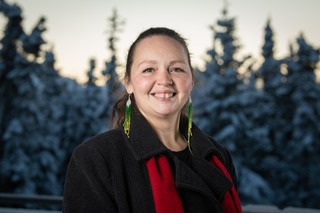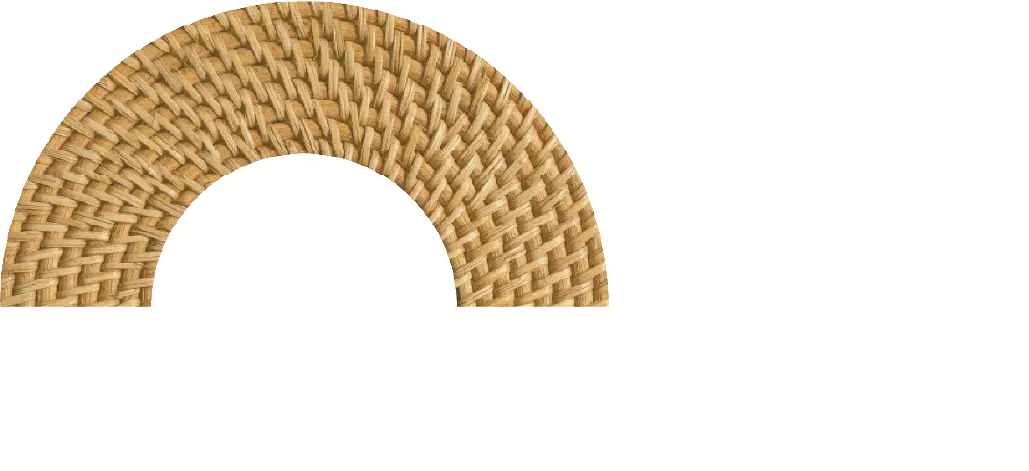
CIRI shareholder Amber Christensen Fullmer (Inupiaq) decided to mark her hands and arms with traditional lines because, as a mixed-race person, “I could step out of being Native and into whiteness without thinking about it,” she explains. “It started to make me really uncomfortable because I didn’t want to step out of it.”
Traditional Inuit tattooing was a part of life and religion in the Arctic. In Alaska and other areas of the circumpolar north, women have been working in the last decade to revitalize the tattooing tradition, which was wiped out when Western colonization swept Alaska in the 19th and 20th centuries.
“I cried when I got marked with my traditional lines because I was releasing pain and reclaiming (my heritage),” Amber recalls. “And then I was there when my daughter got her lines, and I cried again because she was laughing and it was so happy. My daughter really identifies with her Native heritage and has found such a cool way of being 100% herself. My two sons grew up with an awareness as well. If this is the generation that’s coming up, we’re going to be okay.”
Amber is connected to CIRI through her mother, Diane Valerie Templeton Macleod, and maternal grandmother, Edna Swanson Templeton, both of whom were original shareholders. Though Amber was born and raised in Anchorage, her family originally hails from Alaska’s Norton Sound region. Growing up, “since I lived mostly with my grandmother, there was an awareness of our Alaska Native heritage, but it wasn’t encouraged,” she said. “My grandmother was the product of colonization; she didn’t eat traditional foods or speak Inupiaq.
“She was conflicted about being Native, and so her kids were pretty conflicted,” Amber continued. “The vast majority of the kids didn’t care either way, but one was completely against it and wanted to make sure everybody marked ‘Caucasian’ on all demographic forms, even at the Native center, and would always tell me how lucky I am that I look white and can pass for white. And then there was another one who really did a deep dive into Native culture and had a career in it.”
Amber said the “most positive connection” she had to her Alaska Native heritage growing up was through the Anchorage School District’s Title VI Indian Education program, which offers academic assistance, counseling, and cultural enrichment to Alaska Native/American Indian (AN/AI) students. “I lucked out being put in the gifted track, so I never got made fun of going to Indian Education,” she explained. “It wasn’t tutoring for me, so I was able to connect to the cultural aspect. But I have friends my same age who had the opposite experience.”
After graduating in 1996 from West Anchorage High School, Amber earned a bachelor’s degree in sociology/psychology from the University of Alaska Anchorage (UAA) and pursued a career in law enforcement. She started as a youth counselor for institutionalized girls at McLaughlin Youth Center in Anchorage, became a juvenile probation officer and spent the last five years of her law-enforcement career (2007-2012) in Colorado as an adult probation/parole officer.
Amber received her master’s degree in community-clinical psychology in 2011 from the University of Alaska Fairbanks (UAF), returned to Alaska in 2012 and was hired by UAA as an adjunct instructor in 2013.
“As I started adjuncting more, I realized I really wanted to be in academia,” Amber said. “I ended up getting a tenure-track faculty position in 2016, which allowed me to work within the system and have a different impact.
“Working in law enforcement, the system really burned me out,” she explained. “People always say to me, ‘Of course you got burned out, you were working with criminals!’ Actually, I enjoyed working with the criminals; I left the system because it’s broken and needs to be rebuilt. If, as an instructor, I can educate and train the people going into the system, maybe they’re the ones to change it.”
In January, after six years of being an instructor, Amber transitioned to director of UAA’s Native Student Services (NSS) department. She is simultaneously pursuing a Ph.D. in Indigenous studies at UAF and expects to graduate in 2021.
“Before I applied (for the NSS director position), I had a conversation with some people who ended up being my bosses – the dean of students, the chancellor and vice chancellor of student affairs – and asked some tough questions about what their intent was with NSS,” Amber said. “The conversation was honest and open and transparent in terms of, they recognized how badly things had been going and the need for something different. Basically, what I was told was that if I applied and was successful, I would be handed a blank slate because we were losing Native students.
“We do okay with recruitment; we have about 20% population in the state and UAA recruits about 20% Native students,” she continued “But we lose AN/AI students quickly, and once we do, they’re gone forever.”
Since coming on as director, Amber’s focus has been on not only recruitment and retention of AN/AI students, but the creation and implementation of a revamped Native Early Transition (NET) program at UAA.
“I didn’t find out until I got the job that the NET program was only five days long,” Amber said. “NSS really only had the students for three days and then nobody really did anything with them after that.”
Under Amber’s direction, NET is now a two-year program. The first year consists of an academic tie-in with courses, “and they meet with me once a week on a Monday so I can see them after the weekend, lay eyes on them, make sure they’re returning to school and doing well,” she said. “It’s all about teaching them to be good college students and taking a proactive approach.” Second semester, students learn about cultural belonging through a pilot program taught by Native Elders.
In their second year, returning NET students are asked to identify a discipline they are interested in and find a professional who can mentor them. They, in turn, mentor first-year students in that discipline.
“After their second academic year, my hope is I hand them off to a specific advisor or faculty member who can offer continuity of care, get them through the bachelor’s program and either get them placed in a job or a furthering-education program,” Amber said. “NSS is focused on a lot of things, but fundamentally, we’re focused on the first two years and retaining our students because that’s the problem we’re having right now.”
As for the future, “I’m still on this journey and I don’t know where it’s going to take me,” Amber said. “I love what I do. I’ve been around UAA since 1997 when I started my bachelor’s degree and I find it hard to believe I’m going to stray far from UAA. But I also know there are some other places I could do some good. For now, I’m excited to see what I can do here.”



